
The Avro Lancaster is a British Second World War heavy bomber. It was designed and manufactured by Avro as a contemporary of the Handley Page Halifax, both bombers having been developed to the same specification, as well as the Short Stirling, all three aircraft being four-engined heavy bombers adopted by the Royal Air Force (RAF) during the same era.

Operation Chastise, commonly known as the Dambusters Raid, was an attack on German dams carried out on the night of 16/17 May 1943 by 617 Squadron RAF Bomber Command, later called the Dam Busters, using special "bouncing bombs" developed by Barnes Wallis. The Möhne and Edersee dams were breached, causing catastrophic flooding of the Ruhr valley and of villages in the Eder valley; the Sorpe Dam sustained only minor damage. Two hydroelectric power stations were destroyed and several more damaged. Factories and mines were also damaged and destroyed. An estimated 1,600 civilians – about 600 Germans and 1,000 enslaved labourers, mainly Soviet – were killed by the flooding. Despite rapid repairs by the Germans, production did not return to normal until September. The RAF lost 56 aircrew, with 53 dead and 3 captured, amid losses of 8 aircraft.
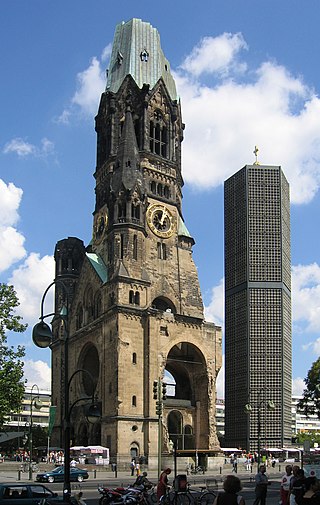
The Battle of Berlin was a bombing campaign against Berlin by RAF Bomber Command along with raids on other German cities to keep German defences dispersed. Air Chief Marshal Sir Arthur Harris, Air Officer Commanding-in-Chief (AOC-in-C) Bomber Command, believed that "We can wreck Berlin from end to end if the USAAF come in with us. It will cost us between 400 and 500 aircraft. It will cost Germany the war".
Grant McLean, CM was a Canadian filmmaker, working as a cinematographer, film director and producer for the National Film Board of Canada (NFB), and serving as its Acting Commissioner through 1966 and 1967.

Wasp Wings is a 42-minute 1945 Canadian documentary film made by the Royal Canadian Air Force (RCAF) Overseas Film Unit and the National Film Board of Canada (NFB). The film takes its name from the colourful markings known as invasion stripes that were painted on Supermarine Spitfire fighter aircraft on D-Day, making them look like "angry wasps".

Train Busters is a 13-minute 1943 Canadian documentary film, directed by Sydney Newman. The film was made by the Royal Canadian Air Force (RCAF) Overseas Film Unit and the National Film Board of Canada (NFB) as part of the NFB's Canada Carries On series. Train Busters depicts the Allied night-bombing campaign over German-occupied Europe that was complemented by close air support missions flown by the RCAF targeting enemy trains.

Wings on Her Shoulder is a 10-minute 1943 Canadian documentary film, made by the National Film Board of Canada (NFB) as part of the NFB's The World in Action series. The film, directed by Jane Marsh, depicts the role of the Woman's Division in the Royal Canadian Air Force (RCAF) during the Second World War, who freed up men for flying duties.
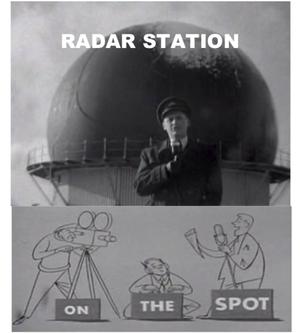
Radar Station is a 1953 Canadian short documentary film produced by the National Film Board of Canada (NFB) as part of the On The Spot series made specifically for television. The documentary involved an account of a visit to a radar station while it is involved in a simulated air attack, and is based on first-person interviews of the staff at the radar station.

Ferry Pilot is a film produced in 1942 by Stuart Legg and Ross McLean for the National Film Board of Canada series The World in Action, in cooperation with the United Kingdom Ministry of Information and the Crown Film Unit. The film has an unaccredited narration by broadcaster Lorne Greene.
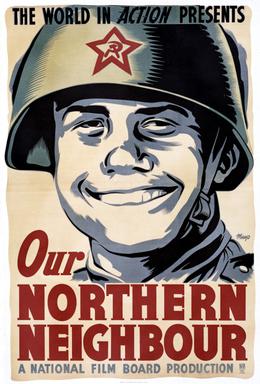
Our Northern Neighbour is a film produced in 1944 by Stuart Legg and directed by Tom Daly for the National Film Board of Canada series The World in Action. The film is narrated by broadcaster Lorne Greene.

The Home Front is a 10-minute 1940 Canadian documentary film, made by the National Film Board of Canada (NFB) as part of the wartime Canada Carries On series. The film was produced and directed by Stanley Hawes.
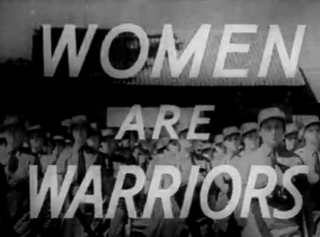
Women Are Warriors is a 14-minute 1942 Canadian documentary film, made by the National Film Board of Canada (NFB) as part of the wartime Canada Carries On series, and dealt with women in war. The film was produced by Raymond Spottiswoode and written and directed by Jane Marsh. The film's French version title is Les Femmes dans la mêlée.
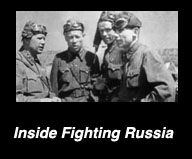
Inside Fighting Russia is a 1942 22-minute Canadian short documentary film produced by the National Film Board of Canada (NFB) for distribution by United Artists, as part of the wartime The World in Action series. The film documents Russia's fight against Nazi Germany during the Second World War. Inside Fighting Russia is produced by Stuart Legg, and narrated by Lorne Greene. The film's French version title is La Russie sous les armes.

Industrial Canada is a 1958 18-minute Canadian short National Film Board of Canada (NFB) documentary film produced, directed and edited by Guy L. Coté for the Canadian Broadcasting Corporation (CBC) television series, as part of the postwar Canada Carries On series. Industrial Canada documents the industrial development of Canada during the mid-1950s. The film's French version title is Le Canada industriel.

The Battle for Oil is a 19-minute 1942 Canadian documentary film, made by the National Film Board of Canada (NFB) as part of the wartime Canada Carries On series. The film was produced by Raymond Spottiswoode and directed and edited by Stuart Legg.The Battle for Oil describes the strategic value of oil in modern warfare. The film's French version title was La Bataille du pétrole.
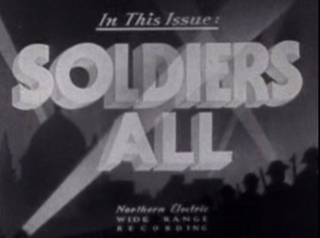
Soldiers All is a 20-minute 1941 Canadian documentary film, made by the National Film Board of Canada as part of the wartime Canada Carries On series. The film was directed and produced by Stuart Legg. Soldiers All describes the experiences in 1941 of soldiers, airmen and sailors in Great Britain and Canada during wartime. The film's French version title is Frères d'armes.

Squadron 992 is a 23-minute 1940 British propaganda film produced by the General Post Office GPO Film Unit of the British Ministry of Information and re-distributed by the National Film Board of Canada (NFB) as part of their wartime Canada Carries On series. The film was directed by Harry Watt and produced by Alberto Cavalcanti. Squadron 992 describes the training and operations in 1940 of No. 992 Squadron RAF, a Royal Air Force (RAF) barrage balloon unit stationed in the United Kingdom. The film's French version title was Escadrille 992.

Quebec – Path of Conquest is an 11-minute 1942 Canadian documentary film, made by the National Film Board of Canada as part of the wartime Canada Carries On series. The film was directed by Radford Crawley and produced by Raymond Spottiswoode. Quebec – Path of Conquest describes the importance of the province of Quebec to Canada and the Allied war effort during the Second World War. The film's French version title is Québec, tremplin stratégique.

Bombing the Nazis is a 10-minute 1943 Canadian documentary film, made by the National Film Board of Canada (NFB) as part of the World War II newsreels shown at theatres in Canada and abroad. The film describes the Allied air war over Europe during the Second World War, concentrating on attacks in 1942 and 1943 on an automobile factory in Vichy France.

Air Cadets is a 15-minute 1944 Canadian documentary film, made by the National Film Board of Canada (NFB) as part of the wartime Canada Carries On series. The film describes the Air Cadet Movement in 1944 during the Second World War. Air Cadets was directed by Jane Marsh, who was also the writer and editor on the production. The film's French version title is Les Cadets de l'air.



















